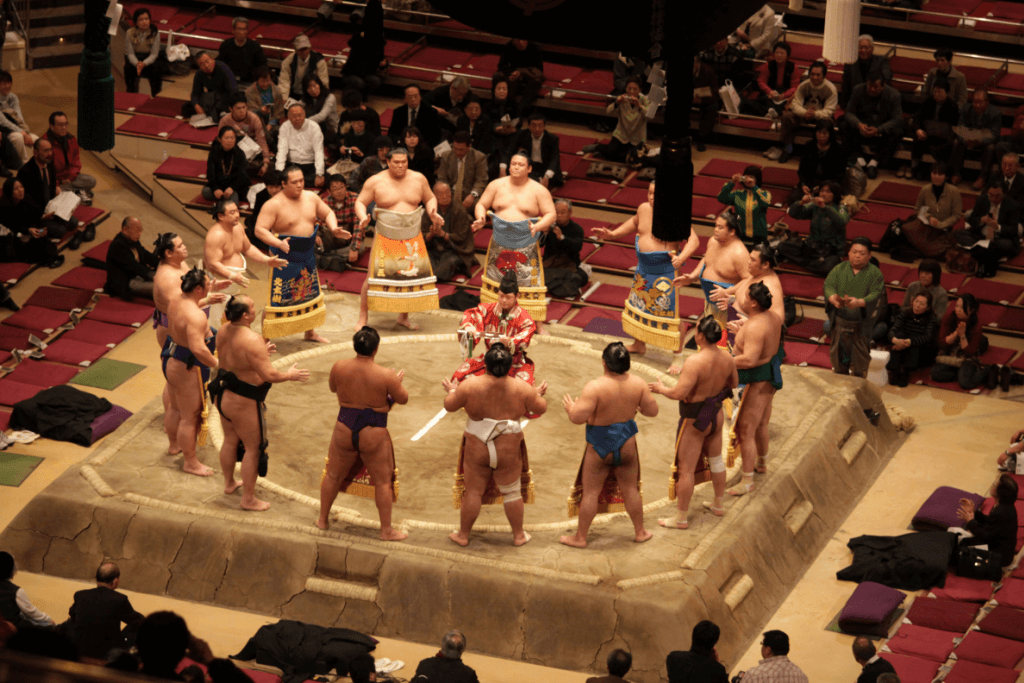The sumo wrestler originated in Japan during the Nara period (CE 710-794) and has become an essential part of Japanese culture. Also known as rikishi, sumo wrestlers are famous for their unique physique and wrestling style and a history veiled in mystery and legends. Let’s explore the fascinating history of sumo wrestlers, their traditions, and today’s tournaments that continue to draw fans worldwide.
Table of Contents
ToggleAncient Beginnings
According to Japanese legend, Takemikazuchi (建御雷/武甕槌), the god of thunder and swords, won the first-ever sumo match. However, in reality, athletes performed the sport in Shinto shrines alongside harvest festivities.

Sumo then changed through the years, going from shrines to becoming martial arts training for samurai. People created an official sumo organization during the Edo period (CE 1603-1867). The first sanctioned sumo tournament occurred during this period at the Tomioka Hachiman Shrine.
Rikishi (Sumo Wrestler) Lifestyle
Sumo wrestlers are known for their unique chonmage (topknot), mawashi (silken loincloth), and massive size. They train daily at a heya (training stable) under the leadership of an oyakata (stablemaster) to develop their strength, balance, and agility. This training often starts early, with most beginning before 7:00 am.

Sumo wrestlers also follow strict diets, which include large amounts of rice, vegetables, and fish, to maintain their weight and build muscle mass. The most common meal is the traditional chankonabe, a protein-rich stew cooked at the table, usually a mix of meat and vegetables with a generous side of rice.

The Sumo Wrestler Tradition
The life of a sumo wrestler is very traditional. They train and eat at the heya, and most sleep there too. They follow strict rules and rituals, with most lower-ranked sumo wrestlers having to clean and cook. In addition, they participate in traditional ceremonies such as the dohyō-iri. Dohyō-iri is a pre-match ritual in which the upper-division sumo wrestlers enter the ring and perform a series of symbolic gestures to purify the arena and show respect to the gods.

Sumo wrestling is a highly competitive sport with six grand tournaments every other month throughout the year. Three are in Tokyo, and the others are Nagoya, Fukuoka, and Osaka. The tournaments last for 15 days and attract thousands of fans worldwide.
Matches take place in a raised circular ring of clay called a dohyō. The winner is the first wrestler to knock the other out of the ring. Another win condition is to have them touch the ground with anything but the soles of their feet.
Are you looking to enjoy even more of traditional Japan this spring? Check out Sakuraco! Sakuraco delivers traditional Japanese snacks, teas, sweets, and snacks from local Japanese makers directly to your door so you can enjoy the latest treats from Japan!

Grand Tournaments
During the Grand Sumo Tournament, the sumo wrestler competes in a “winner takes all,” with the wrestler with the best ratio of wins to losses winning their division. The tournament has six divisions, the highest makuuchi and the lowest jonokuchi, each with its rank structure.
Each day of the tournament, the jonokuchi compete in the morning and then move on to the higher ranks. This event continues until the end of the day when the makuuchi compete. Wrestlers receive a rank based on their tournament performance, and the highest rank, yokozuna, is only for the best wrestlers.
Challenges
Sumo wrestling isn’t without its share of scandals. There have been reports of yaocho (match-fixing) and bullying at the training stables. While hazing is common for newer sumo wrestlers, some incidents are extreme. The sport has also struggled to attract younger fans in a rapidly aging society.
Future
Despite these challenges, the sport has tried to adapt and become more inclusive, with foreign-born wrestlers becoming more common. Outside of Japan, women compete in the sport as well. Some sumo fans haven’t accepted these changes but are leaning toward modernizing the sport. In doing so, they can potentially attract a broader, more international audience.

Sumo wrestling is a fascinating sport with a rich history and tradition. Sumo wrestlers are unique athletes with a dedication to their craft that is inspiring. While the sport has faced many challenges, it continues to evolve and grow and bring in new fans.
Sumo wrestling remains a unique cultural pastime and source of pride for Japan, from its humble beginnings as a religious ritual to its modern-day tournaments that bring fans worldwide.











One Response
I watch the Grand Sumo tournaments on NHK-World. I am having fun learning about it. The tournament that ended recently was notable for a couple of reasons, one being the ozeki and the yokozuna were out due to injury. I never thought I’d get into watching it, but here I am watching every two months.